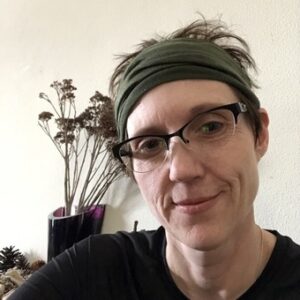
Stephanie Morrissette
Stephanie is an avid naturalist and a Library Assistant in the Adult Services Department at CDPL.
Have you ever wondered what lichen is? Is it fungi, algae, moss, plant, or a combination of all or some of these organisms? Where do lichens grow? Are they found in both rural and urban environments? Join the Library Naturalist for a Lichen Appreciation Hike on Saturday, March 22, at 10 am to learn about lichens. We will wander through Brickyard Nature Park, located at 759 Concord Road, looking for these rather common but elusive organisms on rocks, logs, trees, and branches. We will learn to appreciate an overlooked part of the more microscopic world.
All patrons must sign a waiver which will be available onsite before participating. We will meet in the park’s parking lot by the pavilion for a short lesson on lichens to learn their characteristics and prepare us to observe them in the field. A hand lens is a good item to have in your field bag for magnification. Many lichenologists (lichen scientists) use these to identify small characteristics of lichens, mosses, flowers, and other plant parts.
Lichen are such a bizarre form of life that much is yet to be discovered. The importance of lichens medicinally and medically is only recently being explored by the scientific community. Some lichens prefer tree bark, branches, or rocks. Some lichen communities of different species colonize together, sharing resources. Many varieties serve as a food source, nest material, and camouflage for various animals, birds, and insect species. Additionally, lichens are air quality indicators, and their presence or absence may indicate forms of air pollution that they are sensitive to.
During our hike, we will be introduced to the world of lichens and learn a new appreciation for this often ignored life form. And to be clear, lichens are not plants! They are a combination of an algae or cyanobacteria and a fungus. Lichens most commonly reproduce asexually through fragmentation, which is a genetic clone of the parent lichen, but sometimes via sexual reproduction. The release of spores from the fungal component of the lichen can then be transported via wind, water, or carried off in animal fur to join with compatible algae to form a completely new lichen.
You can stop in the library to check out our new books on lichens: “The Lives of Lichens: A Natural History” by Robert Lucking (579.7 Lucking) or “Lichenpedia: A Brief Compendium” by Kay Hurley (579.7 Hurley), or put in an Interlibrary Loan request for books on lichens from other library collections. Staff will be happy to help you submit your requests via paper copy, or you can go to our website at crawfordsvillelibrary.in.gov and click on the Services tab to find our Interlibrary Loan link. You can submit your form online or in person.
The Crawfordsville District Public Library is open Monday through Thursday from 9 am to 9 pm, Friday and Saturday from 9 am to 5 pm, and Sunday from 1 pm to 5 pm. You may contact the Adult Services Information desk with questions for the Library Naturalist at 765-362-2242 or email ask@cdpl.lib.in.us.
